With its enchanting scent and vibrant colors, Honeysuckle has captured the hearts of gardeners worldwide. Aside from beautifying garden landscapes, these charming climbers are praised for their hardiness and ease of care.
However, does this same charm translate to container gardening? Indeed, “can honeysuckle grow in pots?” is a question many aspiring gardeners grapple with, especially those tight on space or wanting to bring a slice of nature indoors.
This article delves into the exciting world of growing honeysuckle in pots. This isn’t just about aesthetic appeal – the flexibility, convenience, and versatility of container gardening are game-changers for urban dwellers and gardening novices alike.
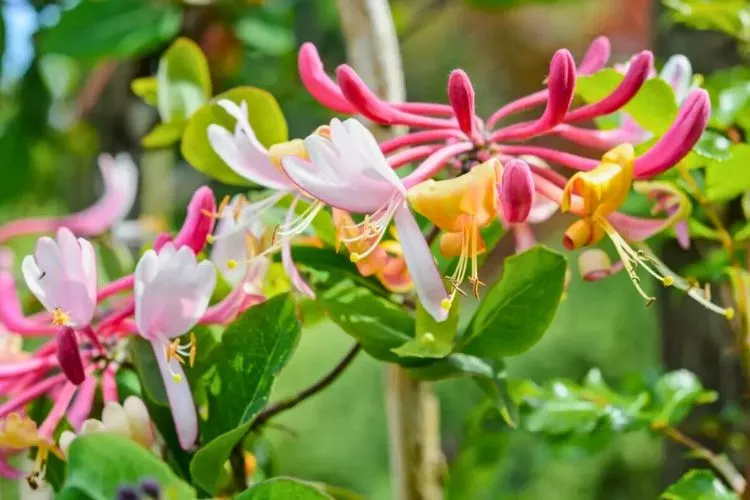
Whether you’re faced with limited garden space or soil issues in your yard, we’ve got you covered. So, join us as we explore how to maximize your green thumb potential, even in the smallest of spaces!
Table of Contents
Understanding Honeysuckle Plants
Honeysuckles, belonging to the Lonicera family, are beloved for their sweetly-scented, tubular flowers. They’re incredibly diverse, boasting over 180 species that range from hardy shrubs to delicate climbers.
With vibrant white, yellow, pink, or red hues, honeysuckles paint a stunning picture in any garden.
Two main types of honeysuckle are often featured in gardens: the Japanese Honeysuckle (Lonicera japonica), known for its vigorous growth and sweet-smelling white or yellow flowers, and the Trumpet Honeysuckle (Lonicera sempervirens), appreciated for its bright red or orange blossoms. But the family isn’t limited to these.
The Siberian Honeysuckle (Lonicera tatarica), with its pink spring blossoms, and the Purple-leaf Honeysuckle (Lonicera purpurea), bearing purple-tinted leaves and creamy flowers, add unique touches to the assortment.
Honeysuckles are generally unfussy about their environment but have certain preferences. They flourish in well-drained soil, prefer a good amount of sunlight, but can tolerate some shade.
They are also fast growers, which makes them a hit among gardeners looking for quick results.
Compact or less aggressive honeysuckles are often a good choice for container gardening to prevent overgrowth.
Some suitable varieties include the ‘Goldflame’ (Lonicera x heckrottii ‘Goldflame’), which displays lovely pink and yellow flowers, or the ‘Mint Crisp’ (Lonicera japonica ‘Mint Crisp’), recognized for its variegated leaves and fragrant blooms.
Whichever type you choose, honeysuckle can prove a delightful addition to your pot garden!
Can honeysuckle grow in pots?
The short answer to this question is: absolutely, yes! Honeysuckle can thrive in pots, transforming your balcony, patio, or indoor space into a blooming garden sanctuary.
This flexibility makes honeysuckle a favorite choice for urban gardeners and anyone grappling with limited gardening space.
However, the secret to successful container gardening with honeysuckle lies in understanding and meeting its needs diligently. While these plants are generally hardy and adaptable, growing them in pots necessitates attention to the choice of container, type of soil, and the plant’s watering, light, and nutritional needs.
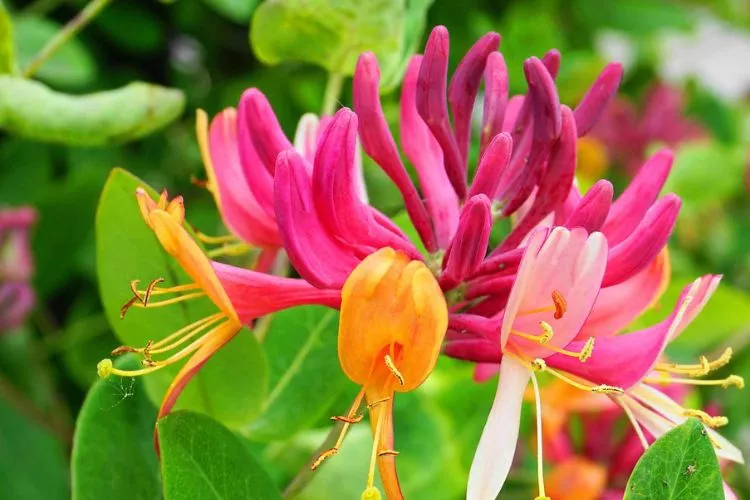
Potted honeysuckle offers a wealth of benefits. Aside from adding visual appeal, they provide a movable garden feature that you can position according to sun exposure or even bring indoors during harsh weather conditions.
Plus, growing honeysuckle in containers allows for better control over soil quality and easier management of potential pest or disease outbreaks.
Ultimately, growing honeysuckle in pots isn’t just possible – it’s a rewarding gardening experience that brings the beauty and fragrance of these plants closer to you, wherever you choose to place them.
Stay with us as we dig deeper into how you can create the ideal pot home for your honeysuckle plant!
Pros and Cons Growing Honeysuckle in Pots
Like any gardening approach, growing honeysuckle in pots has its share of pros and cons. Considering these factors is essential to ensure your honeysuckle thrives and brings joy rather than frustration.
Pros
- Flexibility: Container gardening provides flexibility. You can easily move your honeysuckle to follow the sun, shelter it from harsh weather conditions, or simply rearrange it for aesthetic purposes.
- Soil Control: With potted honeysuckle, you have better control over the soil quality, ensuring the perfect pH and nutritional balance. This control is particularly beneficial if your garden soil is heavy clay or overly sandy.
- Pest and Disease Management: Pests and diseases can be more easily controlled in pots. Any affected plant can be isolated to prevent the spread of disease and pest infestations can be handled more effectively.
- Space-Saver: For those with limited outdoor space, pots allow you to bring the beauty of honeysuckle to your patio, balcony, or even indoors.
- Accessibility: Potted plants are easier to access for care and maintenance and beneficial for individuals who may find bending or kneeling difficult.
Cons
- Watering Requirements: Potted honeysuckle requires more frequent watering than ground-planted ones. Pots tend to dry out quickly, especially in hot weather, requiring diligent attention to prevent wilting.
- Limited Growth Space: While honeysuckle is adaptable, they have extensive root systems. Pots limit the space these roots can explore, potentially impacting the plant’s growth.
- Overgrowth: Some vigorous honeysuckle varieties can quickly outgrow their pots, necessitating regular pruning or upsizing the pot.
- Winter Care: In areas with harsh winters, potted honeysuckle requires extra protection as pots don’t insulate roots as well as the ground does.
- Regular Repotting: To avoid a root-bound plant, repot your honeysuckle periodically. This task can be labor-intensive, especially with larger plants.
Understanding these pros and cons helps you make an informed decision and prepares you for the commitment of growing honeysuckle in pots. With this knowledge, you can enjoy the rewards of your container garden while minimizing potential difficulties.
How to Choose the Right Pot and Soil for Honeysuckle?
Choosing the right pot and soil is crucial when growing honeysuckle in containers. It can make the difference between a thriving plant and one that struggles to survive.
Here’s how to select the right home for your honeysuckle.
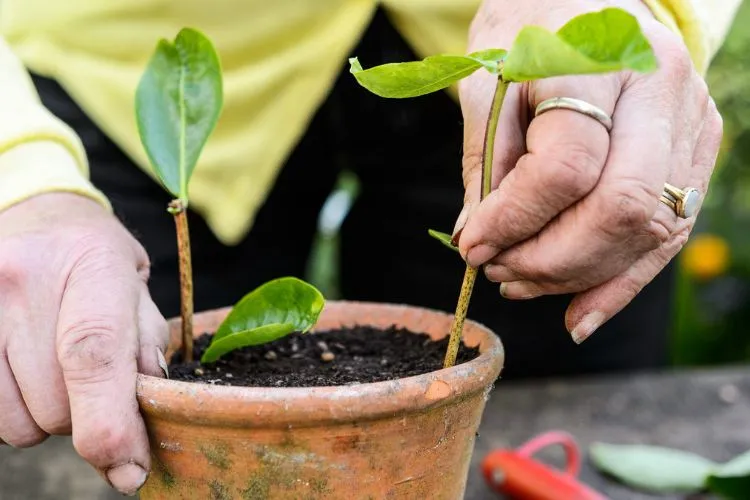
Choosing a Suitable Pot
When selecting a container, you must consider size, material, and drainage.
Honeysuckle is a vigorous plant with a healthy root system. Start with a pot at least 12-15 inches (30-38 cm) in diameter, giving your plant room to grow. As it matures, you may need to upsize the pot or prune the roots to avoid a root-bound plant.
Material-wise, you have a range of options. Clay or terracotta pots are breathable and good for root aeration but dry quickly. Plastic pots retain moisture well but can overheat in the sun. Wood or ceramic pots strike a balance between moisture retention and breathability.
Importantly, ensure the pot has ample drainage holes. Honeysuckle dislikes waterlogged conditions, which can lead to root rot. If your chosen pot lacks sufficient drainage, drill extra holes at the bottom.
Selecting the Right Soil
Honeysuckle isn’t too fussy about soil but does best in well-draining fertile soil. Use a high-quality potting mix combined with organic compost for added nutrients. A blend of two-thirds potting mix and one-third compost generally works well.
Remember, honeysuckle prefers slightly acidic to neutral pH levels (around pH 6-7). Add some garden sulfur to lower the pH if your soil is too alkaline.
By providing the right container and soil for your honeysuckle, you’ll set it up for a successful journey in container gardening. Remember, your honeysuckle’s growth and overall health are significantly influenced by its living conditions, so take the time to get them right!
Honeysuckle In Pots: Planting and Care Guidelines
Although this versatile plant is fairly easy to grow, understanding the specific planting process and subsequent care requirements is crucial. This section guides you through the best practices to ensure your honeysuckle thrives in its potted home. Let’s get started!
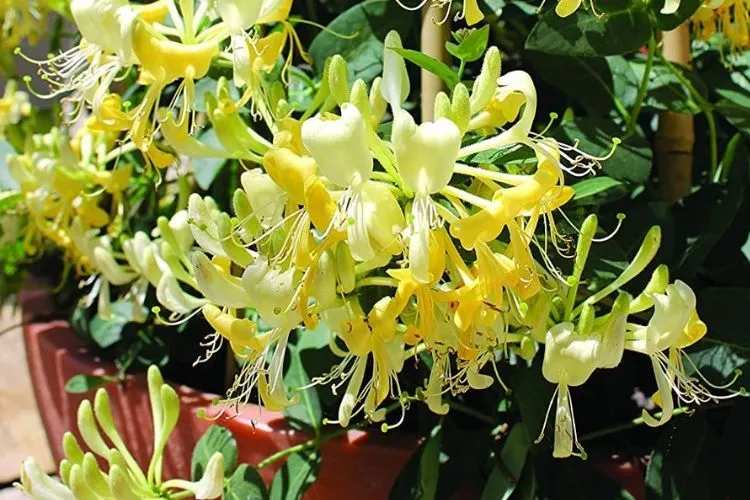
Step-by-step instructions for planting honeysuckle in pots
Let’s dive into the process of planting your honeysuckle in a pot. Follow these steps to ensure a healthy start for your plant:
- Select the Right Pot: As mentioned earlier, start with a pot that is 12-15 inches (30-38 cm) in diameter with ample drainage holes. It should be deep enough to accommodate the root system of your honeysuckle plant.
- Prepare the Pot: Layer the bottom of your pot with small stones or pieces of broken terracotta to further improve drainage. This layer will prevent soil from clogging the drainage holes and keep your plant’s roots healthy.
- Add the Soil: Fill your pot with the previously discussed soil mixture, leaving some space at the top. The two-thirds potting mix and one-third compost blend work well.
- Plant Your Honeysuckle: Now it’s time to plant. Make a hole in the soil large enough for your honeysuckle’s root ball. Place your plant in the hole, ensuring the top of the root ball is level with the soil surface. Then, fill in around the root ball with more soil, pressing gently to secure the plant.
- Water Generously: After planting, water your honeysuckle thoroughly until you see water running out of the drainage holes. This initial deep watering will help the soil settle around the roots and remove air pockets.
- Place in a Suitable Spot: Position your potted honeysuckle in a sunny or semi-shaded location. Remember, it can be moved as needed to get the right balance of sunlight.
- Support: If you’re growing a climbing variety, provide a trellis or support for your honeysuckle to grow on. Insert the support into the pot when planting to avoid damaging the roots later.
With these steps, you’ve successfully planted your honeysuckle in a pot! Remember, the initial setup greatly influences the plant’s future growth and health, so take your time to do it right.
Now, let’s delve into additional care guidelines:
- Sunlight and Temperature Requirements: Most honeysuckles enjoy full sun to part shade. If you’re in a hotter climate, providing afternoon shade can protect the plant’s leaves from scorching. Honeysuckles are resilient, able to withstand a range of conditions, but they typically thrive in temperatures between 60°F and 75°F (15°C to 24°C).
- Fertilizing and Pruning Honeysuckle in Pots: Feed your honeysuckle with a balanced fertilizer early in spring, then again in mid-summer. Prune as needed to control the plant’s shape and size. It’s best to prune in late winter or early spring. Make sure to promptly remove any dead, damaged, or disease-infected growth.
- Managing Pests and Diseases: Check for common pests like aphids and issues like powdery mildew. An insecticidal soap can help control aphids, and a fungicide can manage powdery mildew. Ensure your plant has good air circulation and avoid waterlogged soil to prevent these problems.
By integrating these tips into your honeysuckle care routine, you’ll set the stage for a healthy, vibrant, and sweet-smelling plant that brings joy to your garden.
Maintenance and Support
Growing honeysuckle in pots is a rewarding endeavor, but as with all container gardening, it demands a certain level of commitment to regular maintenance.
Even though they’re hardy by nature, Honeysuckle plants still rely on their caregivers to ensure they’re growing in optimal conditions, particularly when confined to the limits of a pot.
A key aspect of potted honeysuckle maintenance is monitoring and managing its growth habit. As these plants are climbers, providing a support system like a trellis, a wall, or a fence is crucial for their development.
If you’ve opted for a climbing variety, your honeysuckle will reach out with its twining stems in search of a surface to ascend. A sturdy trellis installed within the pot will guide the plant’s growth and create an enchanting vertical display.
But why limit yourself to a traditional trellis? Feel free to get creative. An array of structures like obelisks, arches, pergolas, or even repurposed ladders can provide the necessary support.
Remember to ensure the structure is secure enough to withstand the weight of the plant as it grows.
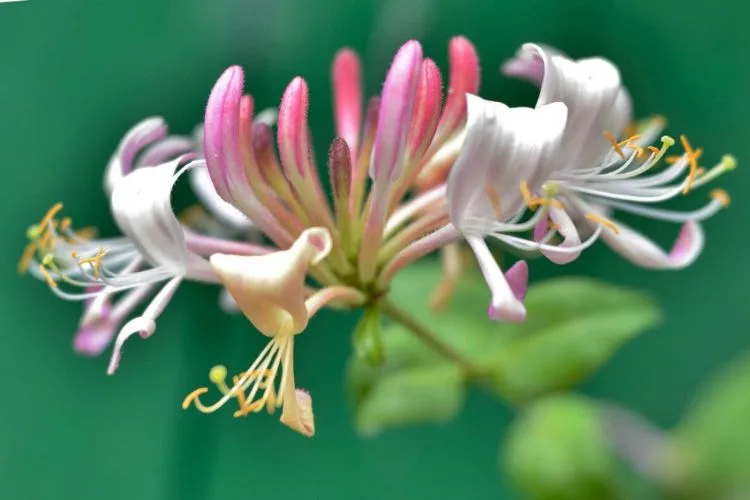
Next, let’s talk roots. Root maintenance is of paramount importance in container gardening. Honeysuckle has a vigorous root system that can quickly fill a pot.
Regularly check the bottom of your container for roots growing out of the drainage holes, a sign that your honeysuckle is root-bound. It’s recommended to repot your honeysuckle every 2-3 years to avoid this problem.
Transfer the plant to a larger container or prune the roots back and replenish the pot with fresh soil when repotting.
Lastly, remember to mulch the top of the soil. This protective layer retains moisture, suppresses weeds, and adds organic matter to the soil as it breaks down. It also prevents the plant’s surface roots from being exposed to harsh weather conditions.
Taking care of your potted honeysuckle requires regular maintenance but is not overly burdensome. With adequate support and mindful root care, your honeysuckle will continue to flourish, rewarding you with its delightful blooms and sweet fragrance season after season.
Frequently Asked Questions (fAQs)
Can all honeysuckle varieties be grown in pots?
Yes, all honeysuckle varieties can be grown in pots, but dwarf or compact varieties are particularly well-suited due to their limited size and growth habits.
How long does it take for honeysuckle to bloom in containers?
Honeysuckle generally takes one to two years to bloom after planting. This can depend on the variety, planting conditions, and care given to the plant.
What are the common pests and diseases that affect potted honeysuckle?
Common pests include aphids and whiteflies, while powdery mildew and leaf spot are common diseases. Good plant hygiene and adequate air circulation can help prevent these issues.
How often should honeysuckle be fertilized in containers?
Honeysuckle in pots should be fertilized twice annually, once in early spring and again in mid-summer, using a balanced fertilizer.
Is it possible to propagate honeysuckle from potted plants?
Yes, honeysuckle can be propagated from semi-hardwood cuttings in late summer or early fall, allowing you to grow new plants from your potted honeysuckle.
How often do I need to water my honeysuckle plant?
In general, water honeysuckle when the top 1-2 inches of soil feels dry. The frequency can vary with the climate, pot, and plant size. Avoid overwatering to prevent root rot.
Conclusion:
As we’ve discovered, growing honeysuckle in pots is possible and brings many benefits – from portability to space-saving advantages.
We’ve explored the essential steps, from selecting the right pot and soil to planting, care guidelines, and ongoing maintenance.
You’ve also gained insight into the common questions surrounding container gardening with honeysuckle. So why not give it a go? You can look forward to your lush and fragrant honeysuckle in a pot with patience and care.
We hope that this guide has been helpful. You can read about similar topics here on our website. Check back again soon for more.


